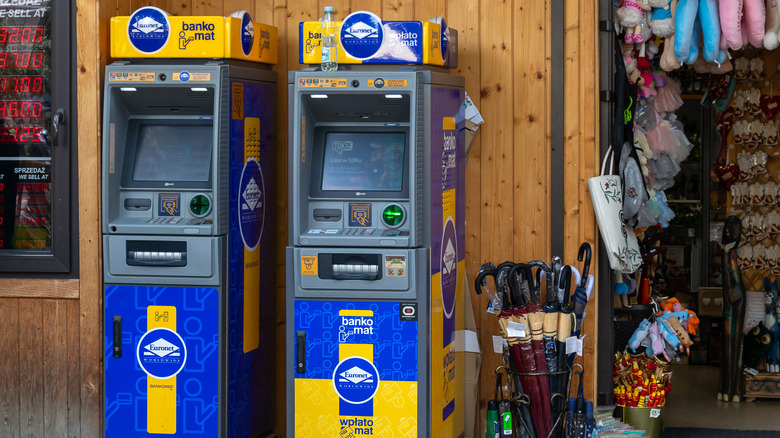The Best Way To Avoid This Frustrating ATM Scam You May Encounter In Europe
Europe draws millions of tourists every year — just over 700 million across the continent — because, well, it's Europe. It's home to picturesque views, history oozing from every cobblestone, and some of the world's safest and most welcoming countries. But with crowds come con artists, and if there's one thing scammers love, it's an enthusiastic tourist. Scams are everywhere, and they're nothing if not creative. From phony friendship bracelets to dodgy taxi drivers scamming you off your travel fund, there's no shortage of traps laid out for unsuspecting visitors. One especially common scam targeting tourists? ATM skimmers. Visiting a cash-heavy destination and need to withdraw? You might want to double-check that ATM.
To the uninitiated, "skimmers" are those barely detectable gadgets that thieves attach to ATMs, designed to snag your credit or debit card details without you noticing. The skimmer sits over the card slot, looking like it's just part of the machine — until your bank statement shows a few extra charges. The untrained eye might not catch it, which is exactly why these devices work. But spotting a skimmer doesn't have to feel like solving a puzzle.
Rick Steves, the travel pro himself, has a tip: "Before inserting your card into an ATM, inspect the front of the machine (especially if it's not inside a bank). If anything looks crooked, loose, or damaged, it could be a sign of a card-skimming device," he wrote on his blog. In short, if the ATM looks a little off, it probably is. Opt for one inside a bank, where the security's presumably tighter. Unfortunately, skimmers aren't the only ATM shenanigans you'll encounter. In fact, Europe has no shortage of ATM tricks that would make any pickpocket proud.
Beware of thieves trying to distract you, too
If thieves aren't using a skimmer to sneakily steal your info, they might be taking a more hands-on approach. Rick Steves warns about another crafty trick: Thieves attach a device to ATMs that traps your card, setting the stage for them to pretend to be a helpful stranger. "They'll either tell you that you can retrieve your card by retyping your PIN, or point to a sign recommending that you enter your PIN twice if there's trouble. Either way, someone is nearby watching you enter your code. Once you give up on getting your card to eject and leave the scene, the criminals collect it and use it," he explains. If you do find your card stuck, don't walk away — Steves recommends asking your travel partner to go straight into the bank to ask for help, avoiding the chance for scammers to swipe your card (or cash) the minute you turn your back.
And if there's no skimmer or card trapper, that doesn't mean you're in the clear. Scammers might be lurking nearby, ready to stage a distraction just after you finish withdrawing cash. "A scammer may pretend to sell you a newspaper, place a €5 bill at your feet and tell you that you dropped some money, or ask you for a charitable donation. Sometimes the scammers are children," Steves adds. Moral of the story: be extra vigilant, especially in these tourist destinations around the world with the highest rates of pickpocketing. That quick ATM stop could turn costly if you're not keeping an eye on your surroundings.
You may also want to watch out for the infamous Euronet 'scams'
If it's not a pickpocket or ATM scammer trying to get your cash, it might just be the ATM itself doing a little "legal" scamming. Euronet ATMs, which seem to pop up in every major European city despite being from Kansas, USA, are notorious for promoting dynamic currency conversion (DCC), a feature that lets you pay in your home currency instead of the local one. While it sounds convenient, DCC often saddles you with terrible exchange rates and can tack on a foreign transaction fee from your bank, turning a simple withdrawal into a money drain.
Travelers frequently report that Euronet ATMs make DCC the default, which means if you're not careful, you might accidentally opt in. And it's not just tourists noticing — even government officials have called out this subtle scam. "Consumers need to gain better knowledge about dynamic currency conversion and how expensive it really is. This can be a surcharge of 8-14 percent. It is a nuisance that tricks consumers into large sums each year," a former member of the European Parliament said in a debate, per Financial Times.
So when you're withdrawing cash, steer clear of Euronet ATMs if you can. If it's the only option, stay alert and decline DCC. As one Reddit user warned, "These [Euronet] machines are basically a scam, charging outrageous fees and offering terrible conversion rates. ... Instead, try and use local banks like Multibanco or others in the area. They usually offer much better rates and lower fees. But if you have no choice and need to use an Euronet ATM, make sure you select 'decline conversion' when prompted. This will ensure that your own bank handles the currency conversion, saving you from their sneaky tactics."


